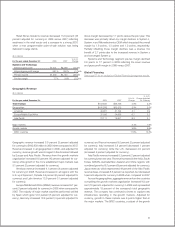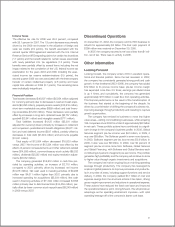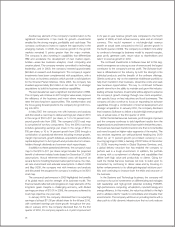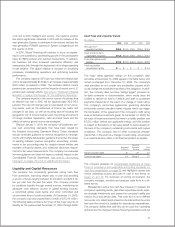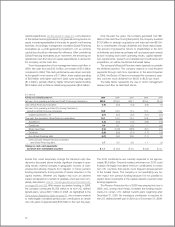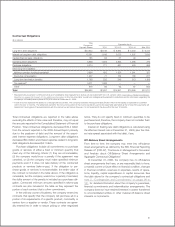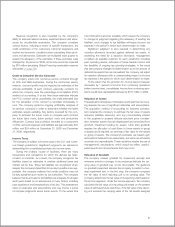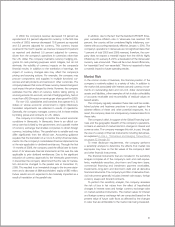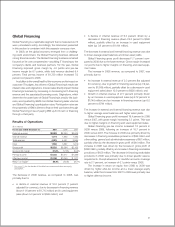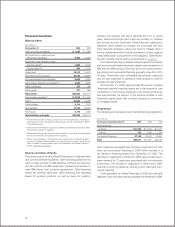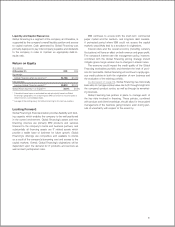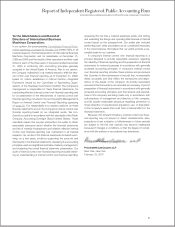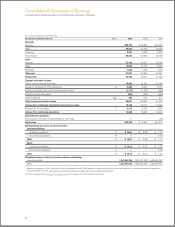IBM 2009 Annual Report Download - page 56
Download and view the complete annual report
Please find page 56 of the 2009 IBM annual report below. You can navigate through the pages in the report by either clicking on the pages listed below, or by using the keyword search tool below to find specific information within the annual report.
to that unit, goodwill is not impaired. If the carrying value of the
net assets assigned to the reporting unit exceeds the fair value
of the reporting unit, then the second step of the impairment
test is performed in order to determine the implied fair value of
the reporting unit’s goodwill. If the carrying value of a reporting
unit’s goodwill exceeds its implied fair value, then the company
records an impairment loss equal to the difference.
Determining the fair value of a reporting unit is judgmental
in nature and involves the use of significant estimates and
assumptions. These estimates and assumptions include rev-
enue growth rates and operating margins used to calculate
projected future cash flows, discount rates and future economic
and market conditions. The company’s estimates are based
upon assumptions believed to be reasonable, but which are
inherently uncertain and unpredictable. These valuations require
the use of management’s assumptions, which would not reflect
unanticipated events and circumstances that may occur.
The annual goodwill impairment analysis, which the company
performed during the fourth quarter of 2009, did not result in an
impairment charge. Utilizing the balances as of September 30,
2009, the excess of fair value over carrying value for each of the
company’s reporting units ranged from approximately $0.4 billion
to approximately $74.7 billion. In order to evaluate the sensitivity
of the fair value calculations on the goodwill impairment test,
the company applied a hypothetical 10 percent decrease to the
fair values of each reporting unit. This hypothetical 10 percent
decrease would result in excess fair value over carrying value
ranging from approximately $0.4 billion to approximately $66.3
billion for each of the company’s reporting units.
Loss Contingencies
The company is currently involved in various claims and legal
proceedings. Quarterly, the company reviews the status of each
significant matter and assesses its potential financial exposure.
If the potential loss from any claim or legal proceeding is con-
sidered probable and the amount can be reasonably estimated,
the company accrues a liability for the estimated loss. Significant
judgment is required in both the determination of probability
and the determination as to whether an exposure is reasonably
estimable. Because of uncertainties related to these matters,
accruals are based only on the best information available at the
time. As additional information becomes available, the company
reassesses the potential liability related to its pending claims
and litigation and may revise its estimates. These revisions in the
estimates of the potential liabilities could have a material impact
on the company’s results of operations and financial position.
Financing Receivables Reserves
The Global Financing business reviews its financing receivables
port folio at least quarterly in order to assess collectibility. A
description of the methods used by management to estimate
the amount of uncollectible receivables is included on pages 78
and 79. Factors that could result in actual receivable losses that
are materially different from the estim ated reserve include sharp
changes in the economy, or a significant change in the economic
health of a particular client or industry segment that represents a
concentration in Global Financing’s receivables portfolio.
To the extent that actual collectibility differs from manage-
ment’s estimates currently provided for by 10 percent, Global
Financing’s segment pre-tax income and the company’s consol-
idated income from continuing operations before income taxes
would be higher or lower by an estimated $54 million (using
2009 data), depending upon whether the actual collectibility was
better or worse, respectively, than the estimates.
Residual Value
Residual value represents the estimated fair value of equipment
under lease as of the end of the lease. Residual value estimates
impact the determination of whether a lease is classified as
operating or capital. Global Financing estimates the future fair
value of leased equipment by using historical models, analyzing
the current market for new and used equipment and obtaining
forward-looking product information such as marketing plans
and technological innovations. Residual value estimates are
periodically reviewed and “other than temporary” declines in
estimated future residual values are recognized upon identifi-
cation. Anticipated increases in future residual values are not
recognized until the equipment is remarketed. Factors that
could cause actual results to materially differ from the estimates
include significant changes in the used-equipment market
brought on by unforeseen changes in technology innovations
and any resulting changes in the useful lives of used equipment.
To the extent that actual residual value recovery is lower than
management’s estimates by 10 percent, Global Financing’s seg-
ment pre-tax income and the company’s consolidated income
from continuing operations before income taxes would be lower
by an estimated $120 million (using 2009 data). If the actual
residual value recovery is higher than management’s estimates,
the increase in income will be realized at the end of lease when
the equipment is remarketed.
Currency Rate Fluctuations
Changes in the relative values of non-U.S. currencies to the
U.S. dollar affect the company’s results. At December 31, 2009,
currency changes resulted in assets and liabilities denominated
in local currencies being translated into more U.S. dollars
than at year-end 2008. The company uses financial hedging
instruments to limit specific currency risks related to financing
transactions and other foreign currency-based transactions.
Further discussion of currency and hedging appears in note L,
“Derivatives and Hedging Transactions,” on pages 92 through 96.
54



